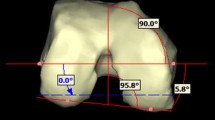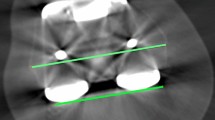Abstract
Background
Rotational alignment of prosthetic components in total knee arthroplasty (TKA) is important to successful outcomes. Component malrotation is a known cause of revision and understanding normal rotational alignment may help recreate normal joint kinematics. To date, no large MRI study assessing femorotibial rotational alignment in nonarthritic knees has been undertaken.
Questions/Purposes
Is Insall’s tibial axis a reliable rotational landmark against common femoral rotational axes in the nonarthritic patient population?
Methods
We reviewed 544 knee MRI scans performed for suspected soft tissue pathology and identified Insall’s tibial rotational axis as well as the femoral clinical trans-epicondylar axis (TEAc), femoral surgical trans-epicondylar axis (TEAs), posterior condylar articular axis (PCA), and a modified Eckhoff’s cylindrical axis. The perpendiculars of these axes were superimposed on Insall’s tibial axis, and the angular differences were measured.
Results
Insall’s axis was internally rotated to the TEAc by 1.4°, externally rotated to Eckhoff’s cylindrical axis by 1.8°, externally rotated to the TEAs by 2.7°, and externally rotated to the PCA by 3.5°. The mean deviation from 0° (optimal alignment for each femoral axis) was significantly greater for the PCA relative to all other femoral axis.
Conclusion
Insall’s axis is a reliable landmark for rotational positioning of the tibial component and may optimize femorotibial kinematics in fixed-bearing TKA.





Similar content being viewed by others
References
Abdel MP, Oussedik S, Parratte S, Lustig S. Coronal alignment in total knee replacement: historical review, contemporary analysis, and future direction. Bone Joint J. 2014; 96-B(7): 857-862.
Aglietti P, Sensi L, Cuomo P, Ciardullo A. Rotational position of femoral and tibial components in TKA using the femoral transepicondylar axis. Clin Orthop Relat Res. 2008; 11: 2751-5.
Akagi M, Matsusue Y, Mata T, et al. Effect of rotational alignment on patellar tracking in total knee arthroplasty. Clin Orthop Relat Res. 1999; 366: 155-63.
Akagi M, Mori S, Nishimura S, Nishimura A, Asano T, Hamanishi C. Variability of extraarticular tibial rotation references for total knee arthroplasty. Clin Orthop Relat Res. 2005; 436: 172-76.
Akagi M, Oh M, Nonaka T, Tsujimoto H, Asano T, Hamanishi C. An anteroposterior axis of the tibia for total knee arthroplasty. Clin Orthop Relat Res. 2004; 420: 213-219.
Amaranath JE, Moopanar TR, Sorial RM. Defining distal femoral anatomy for rotational alignment in total knee arthroplasty: a magnetic resonance imaging-based study. ANZ J Surg. 2014. doi:10.1111/ans.12708.
Barrack RL, Schrader T, Bertot AJ, Wolfe MW, Myers L. Component rotation and anterior knee pain after total knee arthroplasty. Clin Orthop Relat Res. 2001; 392: 46-55.
Bedard M, Vince KG, Redfern J, Collen SR. Internal rotation of the tibial component is frequent in stiff total knee arthroplasty. Clin Orthop Rela Res. 2011. Aug;469(8):2346–55
Berger RA, Crossett LS, Jacobs JJ, Rubash HE. Malrotation causing patellofemoral complications after total knee arthroplasty. Clin Orthop Rel Res. 1998; 356: 144-53.
Berger RA, Rubash HE, Seel MJ, Thompson WH, Crossett LS. Determining the rotational alignment of the femoral component in total knee arthroplasty using the epicondylar axis. Clin Orthop Relat Res. 1993; 286: 40-7.
Bindelglass DF. Rotational alignment of the tibial component in total knee arthroplasty. Orthopedics. 2001; 24(11): 1049-1052.
Bonnin MP, Saffarini M, Mercier PE, Laurent JR, Carrillon Y. Is the anterior tibial tuberosity a reliable rotational landmark for the tibial component in total knee arthroplasty? J Arthroplasty. 2011 Feb;26)2):260–7
Eckhoff DG, Metzger RG, Vandewalle MV. Malrotation associated with implant alignment technique in total knee arthroplasty. Clin Orthop Relat Res. 1995; 321: 28-31.
Fang DM, Ritter MA, Davis KE. Coronal alignment in total knee arthroplasty: just how important is it? J Arthroplasty. 2009; 24(6 Suppl): 39-34.
Hancock CW, Winston MJ, Bach JM, Davidson BS, Eckhoff DG. Cylindrical axis, not epicondyles, approximates perpendicular to knee axes. Clin Orthop Relat Res. 2013; 471(7): 2278-83.
Hill PF, Vedi V, Williams A, Iwaki H, Pinskerova V, Freeman MAR. Tibiofemoral movement 2: the loaded and unloaded living knee studied by MRI. J Bone Joint Surg (Br). 2000; 82-B: 1196-1198.
Incavo SJ, Coughlin KM, Pappas C, Beynnon BD. Anatomic rotational relationships of the proximal tibia, distal femur, and patella: implications for rotational alignment in total knee arthroplasty. J Arthroplasty. 2003; 18(5): 643-8.
Incavo SJ, Wild JJ, Coughlin KM, Beynnon BD. Early revision for component malrotation in total knee arthroplasty. Clin Orthop Relat Res. 2007. May;458:131–6
Insall JN. Surgical technique and instrumentation in TKA. In:INsall JN, ed. Surgery of the Knee. New York NY: Churchill Livingstone: 1993;739–893
KimYH PJW, Kim JS, Park SD. The relationship between the survival of total knee arthroplasty and postoperative coronal, sagittal and rotational alignment of knee prosthesis. Int Orthop. 2014; 38(2): 379-85.
Nakagawa S, Kadoya Y, Todo S, et al. Tibiofemoral movement 3: full flexion in the living knee studied by MRI. J Bone Joint Surg (Br). 2000; 82-B: 1199-1200.
Park IS, Ong A, Nam CH, et al. Transepicondylr axes for femoral component rotation might produce flexion asymmetry during total knee arthroplasty in knees with proximal tibia vara. Knee. 2014; 21(2): 369-73.
Patel AR et al. Femoral component rotation in total knee arthroplaty: an MRI-based evaluation of our options. J Athroplasty. 2014. doi:10.1016/j.arth.2014.02.033.
Paternostre F, Schwab PE, Thienpont E. The combined Whiteside’s and posterior condylar line as a reliable reference to describe axial distal femoral anantomy in patient-specific instrument planning. Knee Surg Sports Traumatol Arthrosc. 2014. doi:10.1007/s00167-014-2836-5.
Romero J, Stahelin T, Binkert C, Pfirrmann C, Hodler J, Kessler O. The clinical consequences of flexion gap asymmetry in total knee arthroplasty. J Arthroplasty. 2007; 22(2): 235-40.
Uehara K, Kadoya Y, Kobyashi A, Ohashi H, Yamona Y. Bone anatomy and rotational alignment in total knee arthroplasty. Clin Orthop Relat Res. 2002; 402: 196-201.
Wernecke GC, Harris IA, Houang M, Seeto BG, Chen DB, MacDessi SJ. Comparison of tibial bone coverage of 6 knee prostheses: a magnetic resonance imaging study with controlled rotation. J Orthop Surg. 2012; 20(2): 143-7.
Author information
Authors and Affiliations
Corresponding author
Ethics declarations
Conflict of Interest
Gregory C. Wernecke, MBBS (Hons); Ian A. Harrris, FRACS (Orth); Bradley G. Seeto, FRACS (Orth); Darren B. Chen, FRACS (Orth); and Samuel J. MacDessi, FRACS (Orth) have declared that they have no conflict of interest.
Human/Animal Rights
All procedures followed were in accordance with the ethical standards of the responsible committee on human experimentation (institutional and national) and with the Helsinki Declaration of 1975, as revised in 2008 (5).
Informed Consent
Informed consent was obtained from all patients for being included in the study.
Required Author Forms
Disclosure forms provided by the authors are available with the online version of this article.
Additional information
Work performed at Sydney Knee Specialists, Sydney Australia
Level of Evidence: Diagnostic Study Level III
An erratum to this article can be found at http://dx.doi.org/10.1007/s11420-016-9503-y.
Rights and permissions
About this article
Cite this article
Wernecke, G.C., Harrris, I.A., Seeto, B.G. et al. Normal Femorotibial Rotational Alignment and Implications for Total Knee Arthroplasty: an MRI Analysis. HSS Jrnl 12, 216–222 (2016). https://doi.org/10.1007/s11420-016-9491-y
Received:
Accepted:
Published:
Issue Date:
DOI: https://doi.org/10.1007/s11420-016-9491-y




